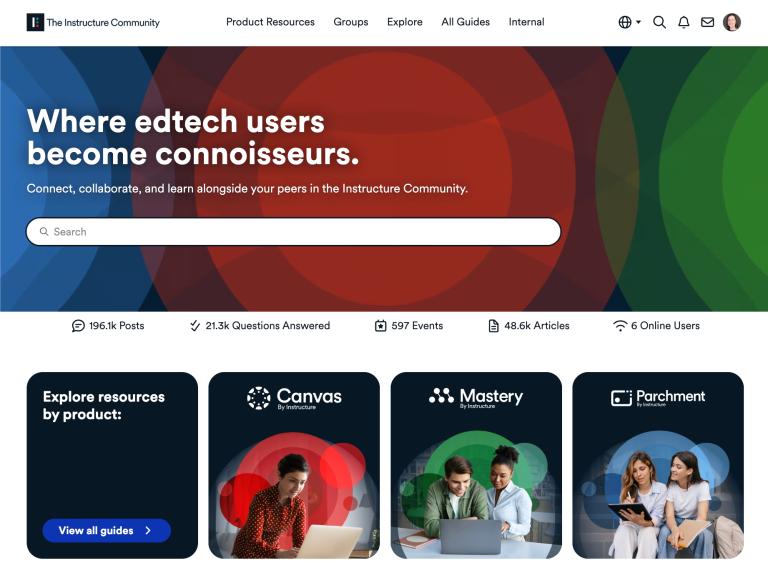2020 Was One for the Record Books. One of the many records set last year was the amount of content and courses that were rapidly put online. And let’s face it, you didn’t have time to worry about how good it looked. That would have been like stopping to pick out a great outfit and fix your hair before heading out the door to respond to an emergency.
But now that we’re out of emergency mode, it’s time to turn our attention back to some of the things we may have neglected out of necessity, since it’s clear that much of the content that made its way into Canvas last year is here to stay.
One of the easiest and most impactful things you can do to transform that emergency content into something more polished and intentional is to focus on the visual or aesthetic design. Let’s explore some of the reasons visual design matters and a way to make good design easy.
Why Looks Really DO Matter
Improving the look and feel of your online courses can accomplish much more than just making things easier on the eyes. In The Students’ Guide to Learning Design and Research (2020), the authors of the chapter on Visual Aesthetics explain:
“Research and practice increasingly recognize that visual design does impact many aspects of the learning experience. It affects the quality of learning, the value of the communication, and the motivation of the audience members. It leverages the brain’s innate capabilities, improves engagement, and satisfies the audience’s aesthetic sensibilities.”
Those all sound like highly desirable things to accomplish, don’t they? But how does good visual design contribute to those outcomes? To name a few, good visual design:
Reduces Irrelevant Cognitive Processing
Simply put, an effective visual design organizes and presents information in an intuitive, consistent, and appealing manner so that students can focus their attention on the content itself, rather than on making sense of the organization of the content. A cleaner, more polished design also reduces the amount of information the student has to take in all at once, enabling them to focus on what is important. Let’s look at a before and after example:
These two pages in a Canvas course have the same content on them, but the second one has a better visual design applied. And what a difference it makes! The effective use of imagery, colors, icons, header styling, and expanders makes it much easier to understand the hierarchy of information and navigate the content.
Improves Perception of Credibility and Value
It turns out that students DO judge books by their covers. Research has shown that aesthetics play an important role in shaping the way that users judge the credibility and value of content. It’s not a big leap to assert that when a learner finds content to be credible and valuable, they are more likely to engage and interact with it. Take, for example, the following before and after Canvas course pages - which one feels more credible to you?
“Design and aesthetics have a profound impact on how users perceive information, learn, judge credibility and usability, and ultimately assign value to a product. To dismiss design as merely visual is to make a fundamental mistake. Style does not replace substance, but style and substance in balance work much better.” (David & Glore, 2010)
Increases Learner Motivation and Engagement
Studies have shown that the aesthetics of an online course, including the layout and the use of images, are important factors in motivating students to engage and persist in the learning process (David & Glore, 2010).
When learners find an online course appealing and easy to use, they are more likely to interact with the materials and maintain interest. So it seems that beauty is more than skin deep.
Let’s take a look at a final before and after example to drive home the idea that good design can make a difference. With which set of activities would you be more likely to engage?
Making Good Design Easy
The challenge is that good design often requires advanced HTML or CSS skills and a lot of time - neither of which are always available to course designers. Making good design easy was the motivation behind the creation of a set of tools known as DesignPLUS - originally developed at Utah State University and now offered as a cloud-based solution by Cidi Labs.
DesignPLUS is an advanced course design toolset that plugs right into Canvas to allow course designers to easily create and style highly polished and engaging content -- without requiring any advanced technical skills.
Perhaps our customers describe it best:
“Using DesignPLUS is the best, fastest and easiest way to make a Canvas course stand out with pizzazz and engagement!”
- Instructional Designer at Embry-Riddle Aeronautical University
“Students deserve to be presented with high-quality content and DesignPLUS design tools make that possible. Implementing consistent course design across entire degree programs is much easier with the assistance of DesignPLUS.”
- Assistant Director of Quality and Assessment at University of North Florida
“With DesignPLUS, we have been able to raise the bar regarding the fit and finish of our Canvas courses. We manage 6 instances of Canvas globally and don’t have a full-time instructional design team. Utilizing the templating tools and getting DesignPLUS in the hands of teaching staff has been a game-changer. ”
- Global Chief Information & Digital Learning Officer at OneSchool Global
To learn more about how you can easily transform your Canvas courses to be more polished and engaging, check out our OnDemand InstructureCon session. In this 20 minute presentation, you’ll see how DesignPLUS was used to transform the before and after pages shown above, as well as examples of what other schools have done with the tools. You can also see more DesignPLUS-styled courses at showcase.cidilabs.com. If you’d like to schedule an in depth demo of DesignPLUS, head on over to cidilabs.com and let us know!
David, A. & Glore, P. (2010). The Impact of Design and Aesthetics on Usability, Credibility, and Learning in an Online Environment. Online Journal of Distance Learning Administration, Volume XIII, Number IV, Winter 2010. https://www.westga.edu/~distance/ojdla/winter134/david_glore134.html
West, D., Allman, B. , Hunsaker, E., & Kimmons, R. (2020). Visual Aesthetics: The Art of Learning. In R. Kimmons & S. Caskurlu (Eds.), The Students' Guide to Learning Design and Research. EdTech Books. https://edtechbooks.org/studentguide/visual_aesthetics
Related Content
 inst-3step.jpg
inst-3step.jpgBlogs
 13lmsfeaturesthatbenefitstudentlearning.jpg
13lmsfeaturesthatbenefitstudentlearning.jpgBlogs
 community-homepage.jpg
community-homepage.jpgBlogs
